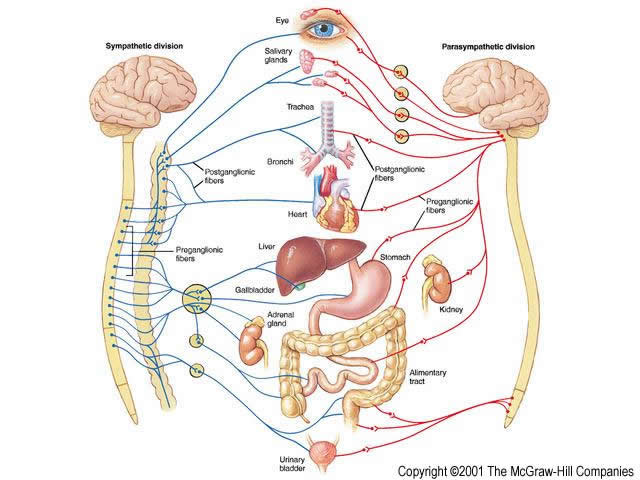The autonomic nervous system (ANS) regulates activity of smooth muscle, cardiac muscle and some glands. Two motor neurons are involved for each regulated site: a myelinated neuron from the CNS to ganglia and an unmyelinated neuron from ganglia to effector. Most organs receive dual innervations: one excitatory (usually sympathetic), the other inhibitory (usually parasympathetic).

All preganglionic neurons use acetylcholine (Ach) as neurotransmitter. Ach is used by postganglionic neurons of the parasympathetic autonomic nervous system (PNS), while catecholamines are the neurotransmitters at postganglionic neurons of the sympathetic nervous system (SNS). An exceptions are the sympathetic fibers to the sweat glands, which use use Ach.

Neurotransmission mediated by catecholamines is known as adrenergic, while that mediated by acetylcholine is cholinergic. Two suffixes are commonly used to describe the action of agents on the ANS: blocking, impairing or otherwise interfering drugs end in "-lytic", while drugs mimicking, enhancing or amplifying action use "-mimetic". Drugs that interfere with the release of catecholamines or block post-junctional receptors are adrenolytic or sympatholytic. A drug that either enhances the action of Ach or stimulates post-junctional cholinergic receptors is referred to as cholinomimetic or parasympathomimetic.
Adrenergic Nerve Junction
Specific sites for drug action at the adrenergic junction include:

Tyrosine is taken up at nerve endings and converted to catecholamines by a series of enzymatic reactions, of which the conversion of tyrosine to dopa by tyrosine hydroxylase is the rate-limiting step:
|
TH
AADC
tyrosine |
 |
Dopamine is stored in vesicles that have their own active transporter. Norepinephrine, the main sympathetic neurotransmitter, is biosynthesized in the vesicles. Epinephrine is only generated in the adrenal medulla.
|
DbH
PNM dopamine |
 |
After norepinephrine is released at the junction, it acts on pre- and postsynaptic receptors before it is taken up into the presynaptic neuron by the Uptake I, a transporter specific to norepinephrine and related amines.

 Catecholamines
left in the cytosol of nerve endings outside vesicles are rapidly degraded by
mitochondrial monoamine oxidase (MAO). Another enzyme that degrades catecholamines
is catechol-o-methyltransferase (COMT), found in nerve endings but more abundant
in liver and kidneys. While Uptake 1 is primarily responsible for termination
of catecholamine action at the synapses (neuronal release), MAO and COMT are
the main termination pathways for circulating catecholamines or similar agents.
Catecholamines
left in the cytosol of nerve endings outside vesicles are rapidly degraded by
mitochondrial monoamine oxidase (MAO). Another enzyme that degrades catecholamines
is catechol-o-methyltransferase (COMT), found in nerve endings but more abundant
in liver and kidneys. While Uptake 1 is primarily responsible for termination
of catecholamine action at the synapses (neuronal release), MAO and COMT are
the main termination pathways for circulating catecholamines or similar agents.
Cholinergic Nerve Junction
Acetylcholine serves as a neurotransmitter at parasympathetic postganglionic terminals, selected sympathetic postganglionic terminals (most sweat glands), all autonomic preganglionic terminals and the neuromuscular junction in skeletal muscle.
 Acetylcholine
is synthesized in the presynaptic nerve terminals by choline acetyl transferase
from acetyl CoA and choline. It is stored in vesicles for later release at the
nerve terminal. Acetylcholine in the synaptic cleft is rapidly degraded by cholinesterase.
Acetylcholine
is synthesized in the presynaptic nerve terminals by choline acetyl transferase
from acetyl CoA and choline. It is stored in vesicles for later release at the
nerve terminal. Acetylcholine in the synaptic cleft is rapidly degraded by cholinesterase.
Key features of cholinergic systems to be exploited with drugs are receptor heterogeneity and rapid degradation of the neurotransmitter by cholinesterase.
The active site of cholinesterase contains binding sites for the quaternary nitrogen and acetyl groups of Ach. After breakdown of the neurotransmitter, the acetylated enzyme releases choline. Almost immediately, the enzyme is regenerated by hydrolysis of the acetyl group.
Need more practice? Answer the review questions below.
1- What is the function of the ANS?
2- How are ANS neurons organized?
3- Which neurotransmitter(s) is(are) used by preganglionic ANS neurons?
4- Which neurotransmitter(s) is(are) used by postganglionic ANS neurons?
5- Define adrenergic, cholinergic, and the suffixes -lytic and -mimetic.
6- List the 4 specific sites for drug action at the adrenergic nerve junction.
7- How are catecholamines synthesized and stored?
8- What happens to norepinephrine after being released at the synapse?
9- What is COMT?
10- List the 3 major ways of terminating catecholamine action and were do they occur.